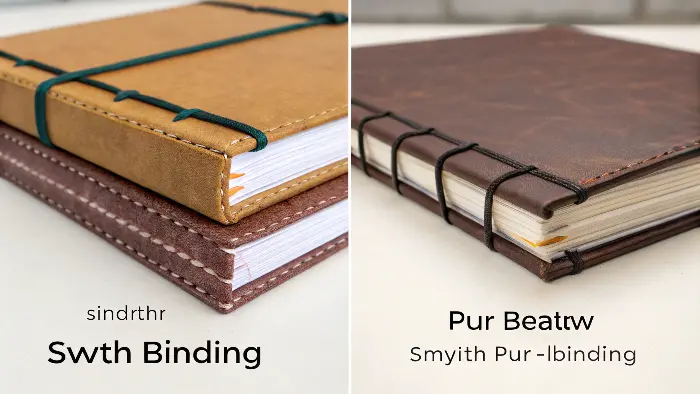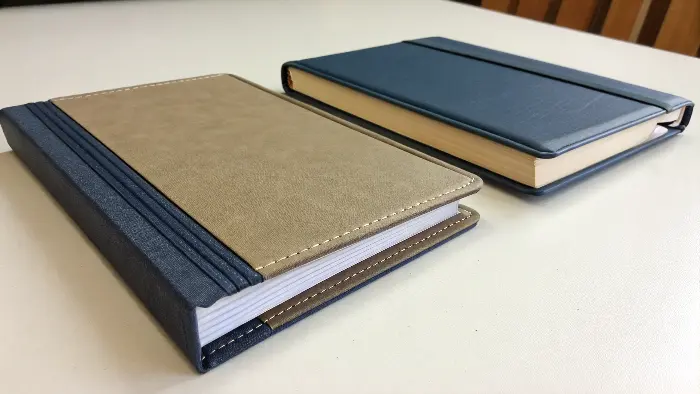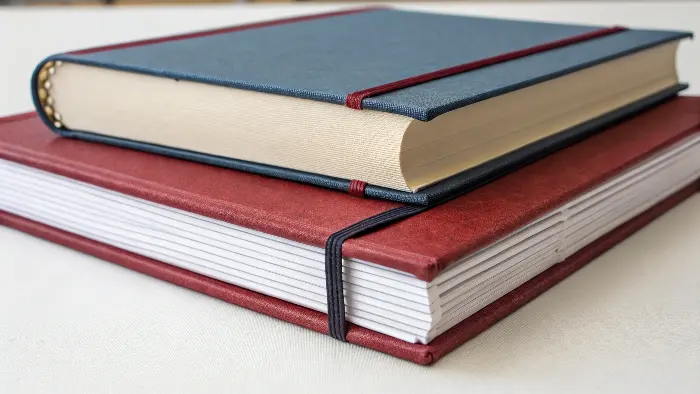Stuck choosing between just hardcover and paperback? It feels limiting, right? But there are so many ways to bind a book, each offering a different feel, function, and cost.
Yes, there are many book binding options beyond standard hardcover and paperback, including saddle stitch, perfect binding, robust PUR binding, and versatile spiral or Wiro-O binding, each suited to different needs.
I get it. When we think "book," our minds often jump straight to the shelf at a bookstore – rows of glossy paperbacks and sturdy hardcovers. And those are great, they absolutely have their place! But as someone who lives and breathes stationery here at Panoffices, I’ve seen how choosing a different binding can totally transform a product. It can make a simple notebook feel luxurious, a manual incredibly user-friendly, or a promotional booklet really stand out. For you, Michael, exploring these alternatives could unlock some really innovative designs for your next stationery collection. So, let’s dive into some of these other cool ways to hold pages together, shall we?
What Are the Different Types of Book Binding Techniques Really Available?
Feeling lost in a sea of binding terms like "saddle stitch" or "PUR"? It can be confusing! Let’s break down some key alternatives to make your choices clearer.
Key alternative book binding techniques include saddle stitch for thin items, perfect binding for standard paperbacks, stronger PUR binding for durability, and spiral/Wiro-O for lay-flat functionality and easy page-turning.
When we talk about "different types," we’re really looking at methods that offer unique advantages beyond the traditional hardcover (case binding) and standard paperback (often perfect bound). Each one has its sweet spot. I’ve seen some really clever uses of these, and it often comes down to what the product needs to do.
Here’s a quick rundown of some popular ones:
- Saddle Stitch Binding:
This is probably the simplest and often most economical method, especially for publications with a lower page count. Think brochures, magazines, or thin booklets. The pages are folded, nested one inside the other, and then secured along the spine with wire staples – usually two or three. It’s quick to produce, which is great for tight deadlines. The main thing to remember is it works best for, say, up to 64 pages, depending on paper thickness. Beyond that, the booklet can start to bulge and not lie flat nicely. I once did a rush job on some event programs using saddle stitch, and we got them turned around in record time! - Perfect Binding (Standard Paperback Style):
This is what you typically see on most softcover novels or trade paperbacks. The edges of the collated pages are milled (roughened up a bit) and then glued directly to a wraparound cardstock cover. The other three edges are then trimmed to give that "perfect," clean finish. It’s a very professional look and generally more durable than saddle stitch for thicker documents. The standard adhesive used is often EVA (Ethylene Vinyl Acetate). While good, it’s not always the most flexible. - PUR Binding:
Now, this is where perfect binding gets a serious upgrade. PUR stands for Polyurethane Reactive adhesive. It’s a much stronger, more flexible, and more durable glue than standard EVA. This means books bound with PUR can withstand more page flexing, lie flatter without the spine cracking, and the pages are much less likely to fall out. It’s fantastic for thicker books, high-use items like manuals or premium notebooks, or when printing on coated papers that can be tricky for other glues. We at Panoffices often recommend this to clients looking for that extra bit of quality and longevity in a softcover format. It costs a little more, but the difference in durability can be huge. - Spiral Binding (Coil Binding) and Wiro-O Binding:
These methods are all about lay-flat convenience and 360-degree page turning.- Spiral Binding uses a continuous plastic coil that’s spun through a series of holes punched along the spine. It’s durable and comes in various colors.
-
Wiro-O Binding (also known as wire-o or twin-loop wire) uses pairs of metal wire loops. It gives a more professional or premium look than plastic coil and also allows pages to lay perfectly flat and turn easily.
Both are brilliant for reports, notebooks, calendars, cookbooks, and presentations – anything where you need to write or refer to it while it’s open flat. The downside? Pages can sometimes tear out at the holes if treated roughly, but for most applications, they’re fantastic.
Here’s a little table to sum it up:Binding Type Process Summary Best For Page Count Lay-Flat Durability Cost Saddle Stitch Folded, nested pages, stapled through spine Thin booklets, magazines, brochures Low (e.g., <64) Fair Low-Medium Low Perfect Bind Pages glued to spine, wraparound cover, trimmed Paperbacks, novels, reports Medium-High Poor-Fair Medium Medium PUR Bind Like Perfect Bind, but with strong PUR adhesive Thicker books, high-use, coated paper Medium-High Good High Medium-High Spiral (Coil) Plastic coil spun through punched holes Notebooks, manuals, calendars, reports Varies Excellent Medium Medium Wiro-O Metal double-loops through punched holes Premium notebooks, presentations, calendars Varies Excellent Medium-High Medium-High This table gives a good overview, Michael. When you’re developing a product, thinking about how the end-user will interact with it often points you to the best binding choice.
What Is the Most Durable Book Binding Method Out There?
Tired of books or notebooks that fall apart after just a little use? Durability is key for quality. Let’s pinpoint the binding methods built to truly last.
For unmatched durability, Smyth sewn binding is generally considered the gold standard. For adhesive methods, PUR binding offers exceptional strength, far surpassing standard perfect binding and making it a very robust choice.

This is a question I get a lot, Michael, and it’s a super important one for any product developer aiming for quality. No one wants their beautifully designed notebook or important manual to shed pages!
When we talk ultimate durability, especially for books that need to last for generations or withstand really heavy use, Smyth sewn binding is often hailed as the king. This is where the signatures (those folded sections of pages) are literally stitched together with thread before being bound into the cover. This mechanical stitching creates an incredibly strong and flexible book block. Think high-quality hardcovers, textbooks, or archival books.
However, not every project needs or can budget for Smyth sewing. So, in the realm of adhesive bindings (which are very common for softcovers and many commercial products), PUR binding is the champion for durability. That Polyurethane Reactive adhesive I mentioned? It forms a bond that’s significantly stronger and more flexible than traditional EVA hot-melt glues used in standard perfect binding. This means pages are much less likely to detach, and the spine can withstand a lot more bending and flexing without cracking. I’ve seen PUR-bound books take a real beating and still hold together impressively. It’s also more resistant to temperature extremes.
Compared to saddle stitching, both PUR and even standard perfect binding are more durable for thicker documents, simply because there’s more surface area for adhesion and a more substantial cover. Saddle stitching is fine for thin items, but the staples can pull through with rough handling.
And, of course, case binding (hardcover) inherently offers great durability because the rigid boards of the cover protect the text block inside, whether that block is sewn or glued. The choice of cover material (e.g., durable cloth vs. paper) also plays a part. It’s not just the binding method alone, but the whole package!What Is the Difference Between Hard Binding and Soft Binding, Really?
Hardcover or softcover – it seems obvious, but the actual construction differences impact everything from feel to longevity. Let’s get clear on what sets them apart.
Hard binding (case binding) uses stiff, rigid boards for the cover, offering maximum protection and a premium feel. Soft binding, like a typical paperback, uses a flexible cardstock cover.

This is a fundamental distinction in the book world, and it’s pretty straightforward once you see them side-by-side. But the implications for your product, Michael, can be quite significant.
Hard Binding, which is technically called case binding, is all about creating a sturdy, durable book with a premium feel. The "case" is made separately: thick, rigid boards (like greyboard or chipboard) are covered with a material like cloth, leather, faux leather, or printed laminated paper. The book block (the collated and secured pages, which can be either sewn or glued with something strong like PUR) is then attached to this case, usually with strong endpapers that are glued to the inside of the cover boards and to the first and last pages of the block.
- Pros: Maximum durability and protection for the pages, a high-perceived value, looks great on a shelf, can last for decades or even centuries if done well. Ideal for special editions, reference books, high-end journals, or anything you want to feel substantial.
- Cons: More expensive to produce, heavier, and takes longer to manufacture.
I remember sourcing some beautiful case-bound journals for a corporate client – they wanted something that screamed quality for their top executives, and hard binding was definitely the way to go.
Soft Binding, on the other hand, uses a flexible cover, typically made from a single piece of cardstock (maybe coated or laminated for extra durability or visual appeal). The most common type you see is perfect binding (which we’ve discussed), but saddle stitching also falls under the umbrella of soft binding as the cover is usually a flexible paper stock. The cover is glued directly to the spine of the book block. - Pros: Lighter in weight, less expensive to produce, generally faster turnaround times. Great for novels, trade paperbacks, magazines, most notebooks, and manuals.
- Cons: Less durable than hard binding; covers can bend, crease, or tear more easily, and pages might be more susceptible to damage at the corners.
For many of Panoffices’ everyday stationery items, like our standard notebooks or planners, a well-executed soft binding with quality paper and a sturdy card cover (perhaps PUR bound if it’s a thicker item) hits that perfect balance of quality, usability, and cost-effectiveness.What Is the Difference Between Paperback and Textbook Binding, Exactly?
Are all "paperbacks" the same? And what makes a "textbook" able to survive a student’s chaotic backpack? The binding plays a huge role in this.
"Paperback" usually refers to perfect-bound books with flexible covers. "Textbook binding" prioritizes extreme durability, often using reinforced perfect binding (like PUR), Smyth sewn signatures even in softcovers, or robust case binding.

This is a great question, Michael, because the terms can sometimes be used loosely, but there’s often a significant difference in construction, driven by the intended use and lifespan of the book.
When we say "paperback," we’re generally talking about the common softcover books you find in bookstores – novels, non-fiction, etc. The vast majority of these are perfect bound. The adhesive used might be standard EVA, or for slightly better quality or thicker books, it could be PUR. The main goal for mass-market paperbacks is often a balance of acceptable quality and cost-effectiveness for a wide readership. They are designed for individual use and aren’t typically expected to endure years of heavy, shared handling.
Now, "textbook binding" is all about durability. Textbooks, especially for school (K-12) and university students, are expected to withstand a lot of abuse – being thrown in bags, passed around, opened flat repeatedly, and used daily for at least a school year, if not longer.
So, how do they achieve this?- Reinforced Adhesives: If a textbook is perfect bound (and many are, especially for college-level softcovers), it will almost certainly use PUR adhesive for its superior strength and flexibility. Standard EVA just wouldn’t cut it for the demands placed on a textbook.
- Sewn Signatures: This is a big one. For maximum page security, many textbooks, even those with soft covers, are Smyth sewn. The signatures are stitched together before the cover is applied. This makes it incredibly difficult for pages to fall out, even with rough handling. You can often tell by looking at the top or bottom edge of the spine – you might see the distinct groups of folded pages (signatures).
- Durable Covers: Textbook covers, whether soft or hard, are usually made from more robust materials. Softcover textbooks often use heavier weight cardstock with a durable laminate (like scuff-resistant matte or gloss). Hardcover textbooks (case bound) are built like tanks, designed to last for many years and multiple students.
- Notch Binding: Sometimes, instead of milling the spine perfectly smooth for perfect binding, a technique called "notch binding" is used. This creates larger, deeper notches in the spine, allowing more adhesive to penetrate and create a stronger bond.
I recall a project where we were developing some study guides for a professional certification. Even though they were softcover, we opted for PUR binding and a slightly heavier cover stock because we knew users would be referring to them intensely over several months. It’s about matching the binding to the anticipated wear and tear. So, while a "paperback" might just be standard perfect bound, a "textbook" implies a binding specifically engineered for a much tougher life!Conclusion
So many choices beyond just hard or soft! Exploring saddle stitch, perfect, PUR, or spiral binding opens up new ways to make your stationery truly functional and appealing.

